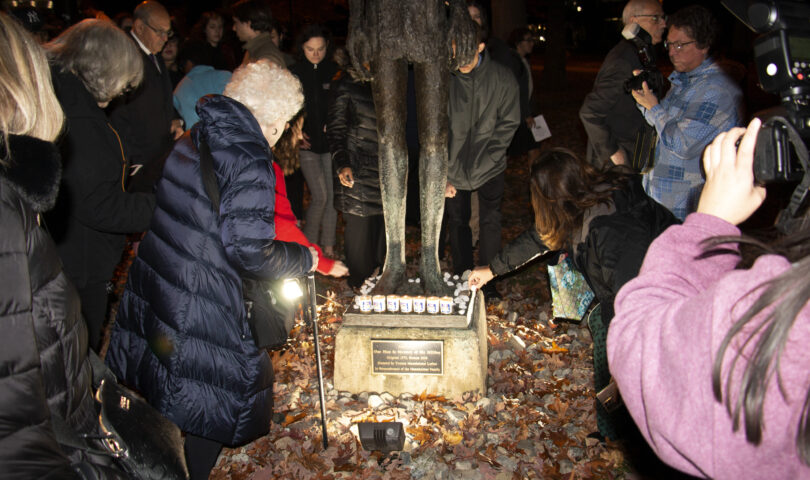Last Wednesday, students, faculty and others gathered in Friends Hall to celebrate the rededication and lighting of the Holocaust statue on campus, “One Man in Memory of Six Million.”
The rededication and lighting, which will now make the statue completely visible at night, are thanks in part to a unanimous resolution passed by the Student Government Association (SGA) 11 months ago. Sophomore SGA members Riley Stein and Evelyn Voitsekhovich wrote the bill last year after an antisemitic remark was made during an SGA meeting.
“The comments made students feel really uncomfortable,” Stein said. “After the comment was made, there were social media posts from various accounts making fun of the statue.”
Stein and Voitsekhovich both pointed to the fact that as student leaders, they have a responsibility to enact change through legislation. “We want to promote awareness of the statue’s historical significance, as well as the lasting impact of the Holocaust on students,” Stein said.
The recent rise in antisemitism across the United States and the world was a key point raised throughout the meeting as well. “Students have a pivotal role in shaping campus culture,” Voitsekhovich said. “If we are able to prevent certain remarks with the illumination of the statue… hopefully we can decrease antisemitism on campus as well as increasing the diversity of our campus community.”
When it was Ramapo President Cindy Jebb’s turn to speak, she thanked the authors of the bill and credited them for leading the initiative during such a difficult time. “Our students embarked on this last year when our nation was experiencing rises in antisemitism, hate crimes and white nationalism,” she said. “They led this initiative with empathy in their hearts and partnered with units and people across our campus and external community to bring us to this place.”
As the Director of the Gross Center for Holocaust & Genocide Studies Dr. Jacob Ari Labendz took to the podium, he mentioned that the attendance for the event exceeded his expectations, and the number of student attendees in particular overwhelmed him.
“From my perspective, it could have been any [form of] bigotry,” he said. “Administrators have to intervene to help nudge the campus community in the right direction… and if I’m being honest, we’re not the right people to do it. It’s the students and the authors who put this together.”
After Labendz finished speaking, SGA President Shannon DeCicco came to the stage to introduce the Ramapo CantaNOVA singers. As the choir sang, audience members lit up the room with tea lights that were provided upon entry to the event.
“The tea lights represent the increase of light that we now have in our lives and our community,” DeCicco said.
After the performance, attendees walked out of Friends Hall and through the Grove, gathering in front of the statue, located near the Berrie Center. As the audience gazed upon the newly illuminated statue, members of the SGA lit candles and placed them at the feet of the statue.
Labendz then invited people to place stones on the pedestal of the statue. He explained that Jewish people, in lieu of flowers, leave stones in memory of the dead. “The stones we leave symbolizes the eternality of the soul and the Jewish tradition, and are a recognition of human value,” he said.
One of the first people to leave a stone on the pedestal was Dr. Judith Peck, the creator of the sculpture and a former Ramapo professor. Peck, who began teaching at the college in 1971, did not speak in front of the crowd but was incredibly moved by the gesture.
“Tears came to my eyes,” Peck said in an interview. “I lived so closely to that sculpture while I was creating it, and nobody was talking in 1970 about the Holocaust… People were not talking because they did not want to remember it, so the people who experienced it were quiet.”
She continued, “I felt so close to [the sculpture] for all these years, so to hear these people talking about it as an individual, as one man, in memory of the over six million who died, I couldn’t get over it… I’m just so moved by this whole ceremony, the fact that the students were the ones who wanted to do this.”
wjackso2@ramapo.edu
Featured photo by William Jackson






